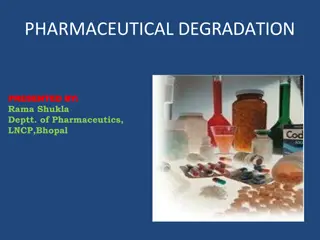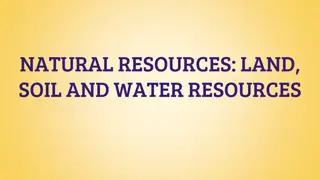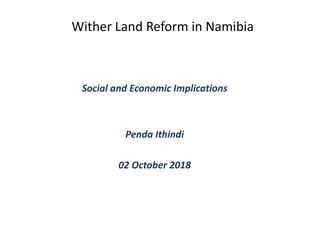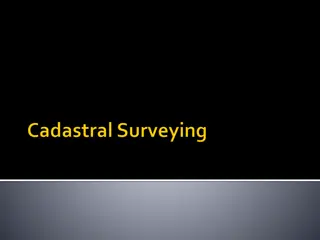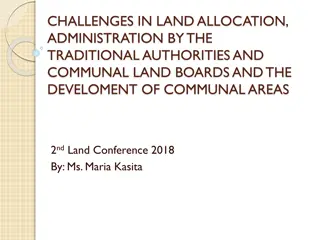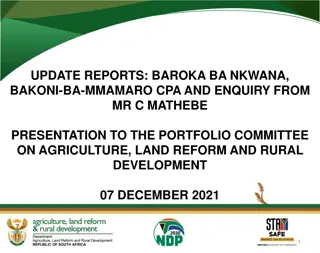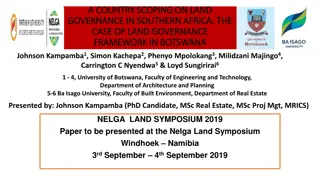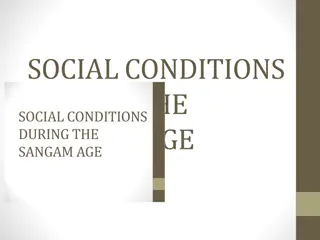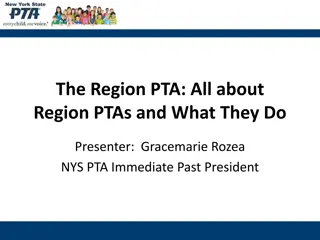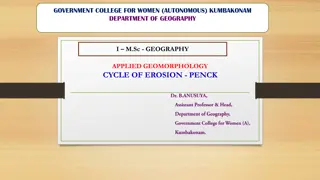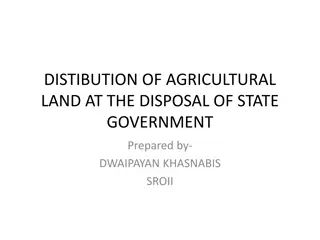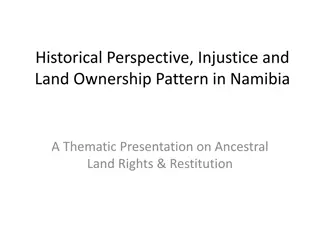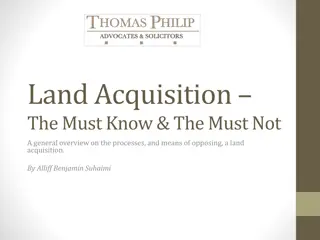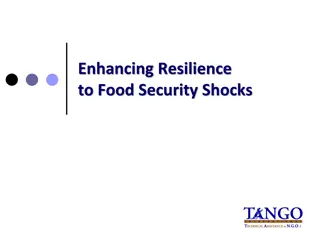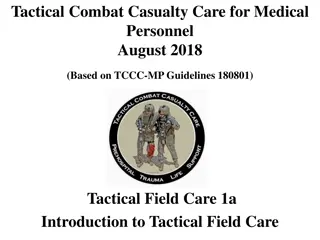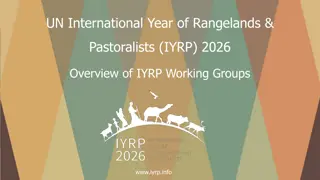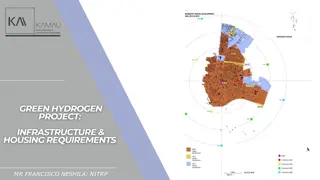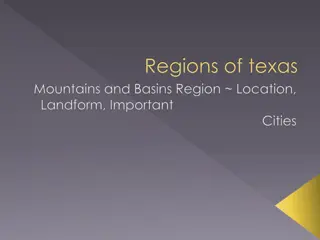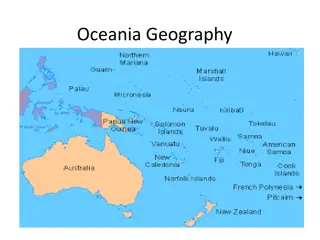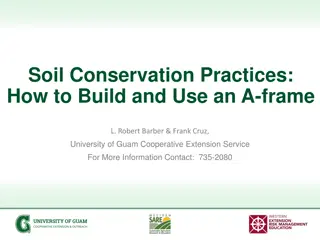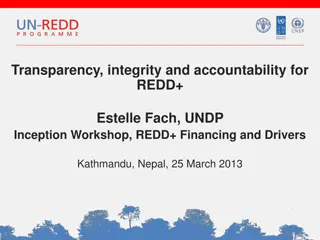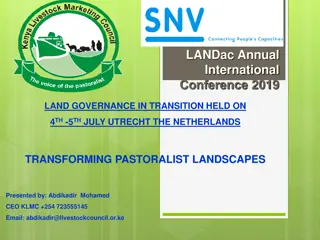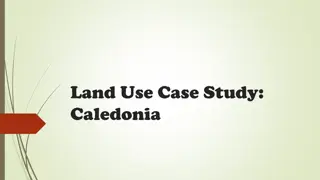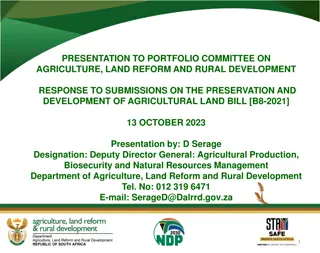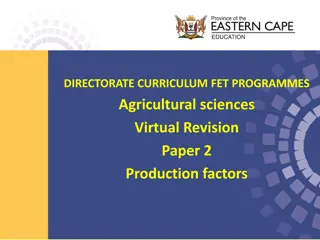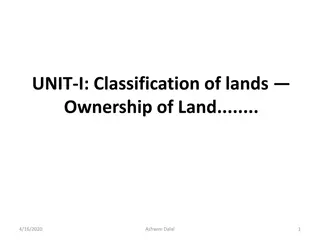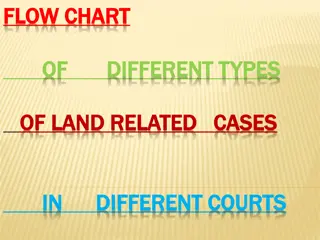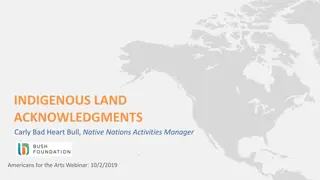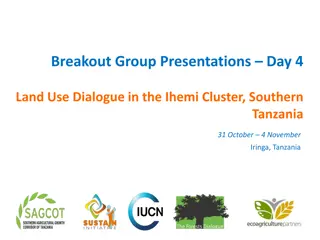Solutions to Combat Land Degradation in the Sahel Region
Addressing land degradation in the Sahel through solutions like diguettes, managing grazing areas, and farmer education can help increase crop yields, prevent soil erosion, and promote sustainable land management. While these solutions have proven effective in various regions, challenges such as initial costs, resource management, and potential environmental impacts need to be carefully considered for successful implementation.
Download Presentation

Please find below an Image/Link to download the presentation.
The content on the website is provided AS IS for your information and personal use only. It may not be sold, licensed, or shared on other websites without obtaining consent from the author. Download presentation by click this link. If you encounter any issues during the download, it is possible that the publisher has removed the file from their server.
E N D
Presentation Transcript
Starter In your groups, come up with a solution to land degradation in the Sahel. How would it help? What would it cost? Why may it not work?
Lesson 4-5: Solutions to land degradation and their effectiveness Learning intention: We are learning about the solutions to land degradation on a semi-arid area. Success criteria I can suggest solutions to land degradation in the Sahel. I can evaluate the solutions to land degradation in the Sahel.
Solution 1 -Diguettes Diguettes are lines of stones laid along the contours of gently sloping farmland to catch rain water and reduce soil erosion. They allow water to seep into the soil rather than run off the land through overland flow. This prevents soil from being washed away and can double to yield of crops groundnuts. such as
Solution 1 -Diguettes Effectiveness: It can be completed as part of a community project at very little cost. Charities such as Oxfam have used this effectively. Communities Burkina Faso have seen crop yields increase by as much as 50%. method very in Mali and
Solution 2 Managing grazing areas Research and tests have shown that grasses are able to re-establish themselves undisturbed fallow period in which to recover (1-2 years). Therefore if areas are fenced off from grazing animals such as sheep and goats on a rotational basis it is possible to sustain the herds without long term damage to the soil. One area is fenced off in order for it to recover. This reduces over grazing and trampling to the soil. very quickly given an
Solution 2 Managing grazing areas Effectiveness: The main disadvantage of this method is the cost of fencing and the management of the grazing areas e.g. in Korr, northern Kenya. Herders harvest woody construction of livestock enclosures to secure their livestock. But this process has led to destruction of whole woodlands within the vicinity of settlement areas and along the routes of livestock movement, leaving some herders with no food supply for their animals. thorn materials mainly for
Solution 3 -Education Farmers are educated to use more appropriate techniques such as terracing, strip cropping and drip irrigation. This helps avoid draining the soil of its nutrients salinisation. and avoiding Drip irrigation, is an irrigation method that saves water and fertilizer by allowing water to drip slowly to the roots of plants, either onto the soil surface or directly onto the root zone, through a network of valves, pipes, tubing, and emitters.
Solution 3 - Education Effectiveness: This can be expensive unless funded by charities, and are often more difficult to implement and manage, resulting in few farmers willing to change their practice. However, if successful, farmers can pass on their new knowledge to their children which does not cost anything and prevents them from using degrading practices.
Solution 4 Fuel efficient stoves The development of stoves like the Jiko, which is cheap and uses approximately half the quantity of fuelwood required by an open fire, can play a part in reducing rural land degradation. If these stoves are used, the demand for fuelwood is reduced and trees will be retained for longer.
Solution 4 Fuel efficient stoves Effectiveness: This technique can be particularly effective where the cost of alternative fuels such as Kerosene, beyond the means of local people. in areas are
Solution 5 Reducing herd size Reducing the number of cattle, sheep and goats and focusing on the quality rather than the quantity of the herds, decreases grazing pressure on the land. It also reduces the impact of soil compaction which causes increased overland flow and reduced infiltration. Effectiveness: This is a very culturally sensitive issue as traditionally the size of the herd is often a measure of an individual s status within his tribe and therefore herders may be resistant to change.
Solution 6 - Afforestation Planting new trees helps prevent soil erosion as the roots will bind the soil together and will also act as a windbreak, reducing wind erosion. In parts of West Africa, the Kad tree, a variety of Acacia has been used in an attempt to restore the soil fertility and productivity. Kad is good because it retains its leaves in the dry seasons so providing shade, and it fixes nitrogen in the soil, thus raising fertility and productivity.
Solution 6 - Afforestation This scheme has other benefits - depending on the species planted trees may also provide nuts and fruit for humans and animals. The Kad tree s decaying leaf litter provides an addition source of nutrients.
Solution 7 Planting pits / Zai Farmers dig a grid of planting pits. Run-off water is trapped in the hole, then manure or compost is added to the hole. Termites are attracted and they dig galleries that make the infiltration of rainwater, run-off and the retention of moisture easier.
Solution 7 Planting pits / Zai Effectiveness: Zai is a simple technique which needs no equipment other than what is available on the land. Zai are usually constructed on abandoned ground, so resulting from this practice bring a benefit of 100%. or crop unused yields https://www.youtube.com/watch?v=x28NpUZjmN8
Solution 8 Great Green Wall The Great Green Wall is an initiative in the Sahel where a wall of trees is planted across Africa on the edge of the Sahara desert in order to prevent desertification. It is nearly 8000km long and stretches from the west to the east coast.
Solution 8 Great Green Wall Effectiveness Other than stopping desertification and erosion, the wall would protect water sources, such as Lake Chad, which has been drying up for decades, and restore or create habitats for biodiversity. The wall would provide energy resources; fruit, vegetables and other foodstuffs; support local economic development; and even political stability in the whole region. It is simply growing trees, but growing solutions and opportunities, resilience to climate change, green jobs that provide a suitable income for African women and youth food security among others. Some people claim there are ownership issues with the Green Wall, and since it is run from the top down and depends on external management and external funds, it may not be possible to run it smoothly. The cost has been criticised and is therefore out the reach of many developing nations.
Videos Great Green Wall 1 Great Green Wall 2 You may wish to take notes.
Task a) Suggest the techniques used to combat rural land degradation in a named rainforest or semi- arid area you have studied. (10) b) Evaluate the methods used to conserve soils in a semi-arid area, commenting on their effectiveness. (10) Write these as a mind map or as perfect answers.
Homework 1. Explain how human activities such as inappropriate farming techniques have caused land degradation in a rainforest or a semi-arid area. (5) 2. a) Suggest the techniques used to combat rural land degradation in a named rainforest or semi-arid area you have studied. (5) b) Evaluate the methods used to conserve soils in a rainforest or a semi-arid area, commenting on their effectiveness. (5)
Success criteria I can suggest solutions to land degradation in the Sahel. I can evaluate the solutions to land degradation in the Sahel.
Plenary What must you do in an Evaluate question?




